A large-fruited variety that summer residents are delighted with - the “Mystery of Nature” tomato
Recently, pink and yellow tomatoes have become very popular. The former have a rich sweet taste, which is ideal for preparing salads, while the latter are non-allergenic and contain substances beneficial to the body.
Thanks to modern breeding, the agronomist was able to develop several varieties that combine the best qualities of yellow and red tomatoes. These include the tomato Mystery of Nature. Its fruits are yellow-pink in color and have a wonderful taste. How to grow such tomatoes on your plot, and what nuances of their agricultural technology should be taken into account - read on.
General description of the variety
Tomato Mystery of Nature is a variety bred by domestic breeders. It is produced by the Siberian Garden company, whose agronomists are considered the creators of this tomato.
The Mystery of Nature was included in the Russian state register in 2008.
Advice! Since the Mystery of Nature is a varietal tomato, the seeds obtained from its fruits are used for planting.

Distinctive features
Tomato fruits Mystery of Nature look very unusual. They combine two colors at once - yellow and pink. Not only the shell of tomatoes, but their flesh is covered with multi-colored spots.
Tomatoes of this variety are interesting not only for their color, but also for their size.. On average, one berry weighs 300-500 g. Reviews from gardeners indicate that the record weight of the fruit reaches 1 kg.
The mystery of nature combines all the advantages of yellow-fruited and pink-fruited tomatoes. They have a sweet taste and firm but juicy flesh. They contain beta-carotene, which helps improve the functioning of the thyroid gland, normalize hormonal levels, sharpen vision and increase the body's defenses. Tomatoes of this color and composition are much less likely to cause an allergic reaction.
The variety is considered salad. Its fruits are not suitable for canning in their entirety. They make juices and sauces. When cooked, tomatoes lose most of their beneficial properties.
Despite their exotic appearance, tomatoes are cold-resistant. This makes it possible to grow them outdoors in regions with a temperate climate.
Among the negative features of the variety are: lack of immunity to tomato diseases. Therefore, it needs careful preventive treatment.
Main characteristics of Mysteries of Nature
Tomato Mystery of Nature is an exotic variety whose pods not only look interesting, but also have a pronounced tomato taste. Its cultivation is complicated by low immunity, but its other parameters will impress novice gardeners.
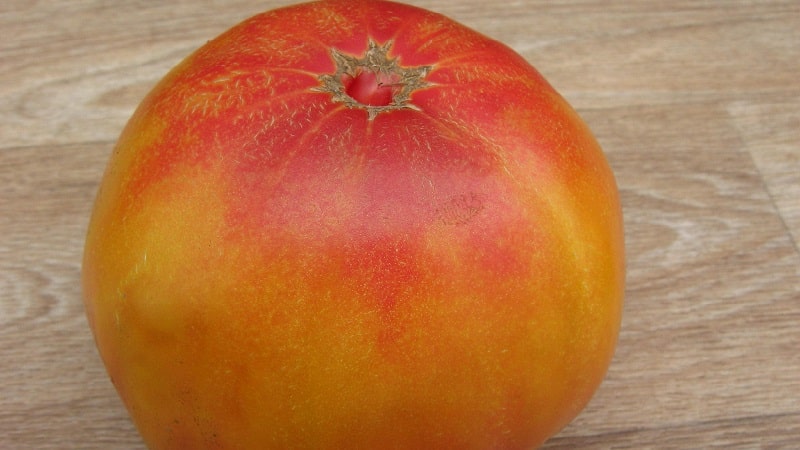
Characteristics and description of the variety:
| Parameter | Indicators |
| Bush type | The Mystery of Nature bush grows throughout the growing season and is classified as indeterminate. The plant reaches a height of 1.5-2 m. Its stems are strong and powerful. The bushes are covered with an average amount of greenery. The leaves are medium sized, simple, dark green. The inflorescences are simple. The first is formed in the axil of 8-9 leaves, the next ones every 3 leaves. |
| Growing method | Tomatoes are resistant to temperature changes. They grow both in open and protected ground. |
| Productivity | High. 7 kg of fruits are harvested from 1 bush per season, subject to proper agricultural technology. From 1 sq. m get up to 20 kg of harvest. |
| Fruit | Big size. One berry weighs on average from 300 to 500 g. There are specimens weighing up to 1 kg. The skin color is yellow, with a pink tip. The inside is yellow-pink, with more pink areas. There is no green spot at the base, but lighter spots may be present. The pulp is dense but juicy. The berries taste sweet, with a slight sourness and tomato aroma. The shape is round, flattened on both sides. There is pronounced ribbing at the base. There are many small chambers in tomatoes, more than 8. They contain a small amount of seeds. |
| Transportability | Low. Tomatoes have a delicate skin that does not protect them well from mechanical damage. They are not suitable for transport over long distances and can be stored for no more than 2 weeks outside the refrigerator. |
| Ripening time | Mid-early tomato. The fruits ripen 105-110 days after sowing the seeds. |
| Disease resistance | Immunity to tomato diseases is low. |
Growing seedlings
Tomato seedlings begin to be grown 2 months before planting in open ground. If you plan to plant plants in open ground, then the seeds begin to be sown at the end of February in the southern regions, in the second half of March in the central zone, and at the beginning of April in the northern part of Russia. To plant tomatoes in a greenhouse, planting material is sown two weeks earlier.
Before sowing tomato seeds experienced gardeners advise familiarizing yourself with the indicators of the lunar calendar. It is believed that tomatoes planted on the correct lunar day grow healthier and stronger.
Other interesting tomato varieties:
Seed preparation
Before purchasing seeds, you need to check their expiration dates.. To ensure the germination of planting material, it is soaked in salted water. Floated specimens are not able to germinate. Those seeds that have sunk to the bottom are washed and used for planting.
Tomatoes, a mystery of nature, have low immunity to tomato diseases. Therefore, their seeds are treated in the factory. The manufacturer indicates information about seed treatment on the packaging, and colors the planting material in light green or orange.
If planting material taken from self-grown tomatoes is used, then it is processed at home. To do this, it is soaked in a solution of potassium permanganate for half an hour or in hydrogen peroxide for a quarter of an hour. Then the planting material is washed.
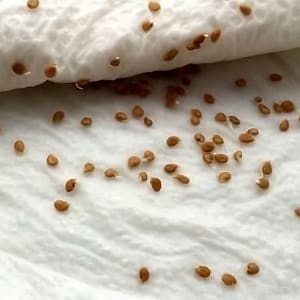 Soaking seeds in a growth stimulator will not only speed up their germination, but also increase resistance to temperature changes and additionally protect against diseases. Eat several popular means for stimulating tomato seeds:
Soaking seeds in a growth stimulator will not only speed up their germination, but also increase resistance to temperature changes and additionally protect against diseases. Eat several popular means for stimulating tomato seeds:
- "Epin";
- "Sodium humate";
- honey water;
- soda solution.
Pieces of gauze are moistened in the selected composition. Planting material is wrapped in them. The fabric with the seeds is placed in a saucer, which is covered with film and placed in a warm place.
Selection of containers and soil
When growing seeds in the usual way, use large containers. Wooden boxes, plastic trays, cake packaging, trimmed 6 liter bottles and other available materials are suitable for these purposes.
Later, the seedlings are planted into individual containers. They use peat and plastic pots, disposable tableware and cut-off bottles.
Advice! Peat pots are considered the most convenient for growing tomatoes. When picking plants to a permanent place, they do not need to be removed from such containers.
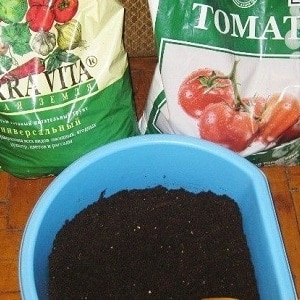 Containers for planting need to be treated. To do this, they are soaked for half an hour in a strong solution of potassium permanganate.
Containers for planting need to be treated. To do this, they are soaked for half an hour in a strong solution of potassium permanganate.
For seedlings take light and nutritious soil. Experienced gardeners advise using soil from a greenhouse as a basis. This will speed up the survival of tomatoes after picking them to a permanent place.
Garden soil is mixed with humus and peat in equal proportions. If the acidity of the resulting soil is high, then ash is added to it (1 tbsp per 1 bucket). The soil for tomatoes is also treated. To do this, it is poured with a strong solution of potassium permanganate or calcined in the oven.
Sowing planting material
Soil is poured into the container for sowing seeds so that 3 cm remains to the edge.. The soil is moistened abundantly with warm, settled water.
Seeds are laid out in rows in boxes at a distance of 2 cm from each other. There should be a gap of 3 cm between the lines of planting material.
The seeds are covered with a centimeter layer of soil on top.. The containers are covered with film and placed in a warm place, with a temperature not lower than +23°C.
Seedling care
To grow healthy seedlings that can quickly adapt to new conditions after planting in a permanent place, you need to follow all the rules of care when growing it:
- Before the first shoots appear tomatoes don't need sunlight. When the plants sprout, they need to be placed in a well-lit place. In spring, they may lack natural light. The lack of light is compensated with the help of fluorescent lamps.
- After the first tomato sprouts appear, the film is not removed for a week. Then the improvised greenhouse is dismantled.
- You need to water the seedlings so that no water gets in not the above-ground part of plants. Only warm, settled water is used for these purposes.
- When will the first true leaves appear on tomatoes?, they are dumped into individual containers. The seedlings are carefully removed from the box along with a lump of earth. It is important not to damage their root system.
- Seedlings are fed three times. The first is 14 days after the pick. The second - 2 weeks after the previous feeding. The last one is 3 days before landing at a permanent place. Complex fertilizers, growth stimulants and vermicompost are used. For one plant, take half the portion indicated on the package. Fertilizer for the last feeding should contain phosphorus.
- 14 days before the pick tomatoes into the ground they begin to harden. The plants are taken outside, gradually increasing the time they spend in the fresh air.
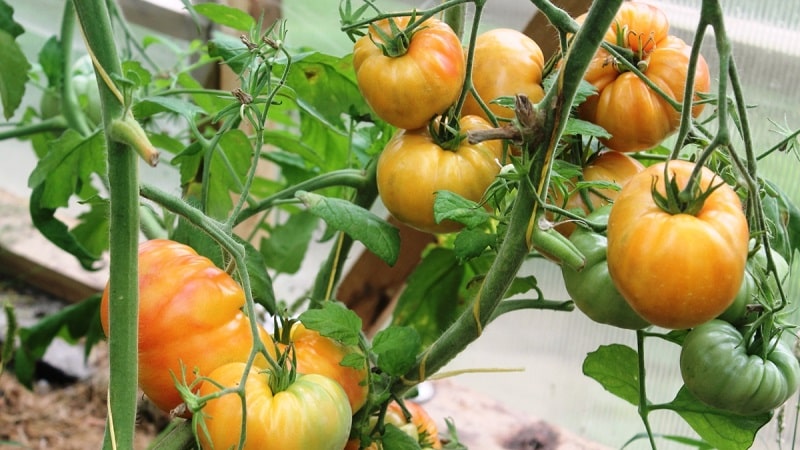
Agricultural technology Mysteries of nature
The mystery of nature is planted in a permanent place when the soil warms up. The outside temperature should not be below +10°C. Otherwise, the plants will die.
Tomatoes are planted in open ground:
- in the south of the country - in the second ten days of April;
- in regions with a temperate climate - in March;
- in the northern regions - in early June.
Tomatoes are planted in the greenhouse 2 weeks earlier. Before picking, the seedlings are watered and fed.
Read also:
Picking seedlings to a permanent place
For tomatoes, choose an area of the garden that is best illuminated by the sun.. Nightshade crops should not grow in this place for the last 3 years. Potatoes are not planted near tomato plantings.
Tomato beds are prepared in autumn. They are cleaned of cultural and weed plant residues. To enrich the soil, humus is spread over the area. Soil acidity is checked using litmus paper. If the indicators are elevated, add dry lime.
In the spring, the area where the tomatoes will grow is dug up. Found plant roots are removed. Chicken manure is added to the soil. To disinfect the soil, water it with copper sulfate.
Digging holes in a checkerboard pattern for planting plants. Their depth should be 25 cm and width 30. Per 1 sq. m place 3-4 holes. Add a tablespoon of ash or long-acting granular mineral fertilizers to each hole. Warm water is poured into the recesses. When the liquid is absorbed, begin planting.
The seedlings are removed from the pot along with a lump of earth. Plants are placed in the holes, forming roots towards the center. Then they are covered with earth, which is carefully compacted.

Tomato care
Tomatoes, a mystery of nature, must be tied up as they grow. To do this, use wooden supports or trellises.
The tomato needs to be shaped. Gardeners recommend leaving 1 or 2 stems. In the first case, the fruits will be larger, and in the second, the yield will be higher.
Plants are planted early in the morning or at sunset. During the pinching process, the lower leaves are removed. Damaged and yellowed foliage should also be removed.
Water tomatoes as the soil dries out. Use 2-3 liters of water per plant. At the height of the day, you should not moisten the soil. This will increase the likelihood of burns on the ground part of the bush.
Tomatoes are fed every 2 weeks. Alternate mineral and organic fertilizers. If long-acting granules were initially poured into the holes, then you will need to fertilize the tomatoes less often. Foliar fertilizing is applied 2 times per season. Use products that contain boron.
Nuances of growing Mysteries of nature
To get the maximum yield of large-fruited tomatoes, you need to know a few nuances of growing them:
- Tomato ovaries need to be thinned. 4-5 of the most beautiful ovaries are left on one brush.
- Tomato bushes after flowers appear on them need to be shaken periodically. This will help their pollination.
- Plant tomatoes once a week. No more than 3 shoots are removed at a time.
- If there is too much green on the plants, then you need to stop fertilizing. This sign indicates that the plants are fattening.
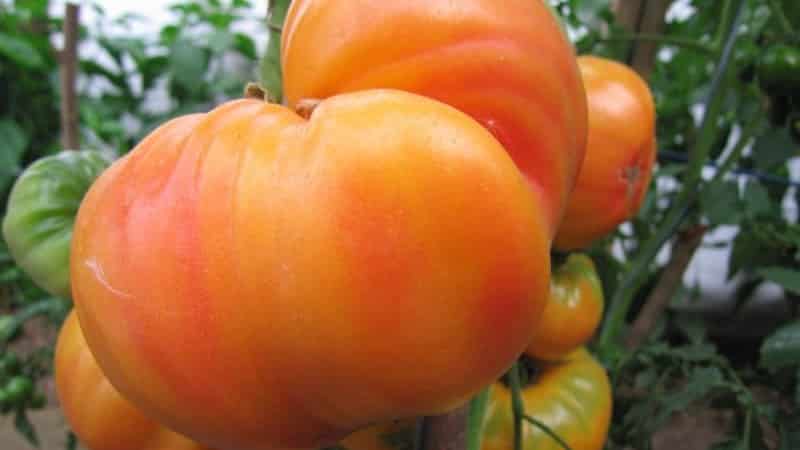
Diseases and pests
Tomatoes of the Mystery of Nature variety are susceptible to plant diseases. To prevent their infection, follow the rules of prevention. Disinfect all tools and materials that interact with plants. It is also important to disinfect the seeds. Plant residues in tomato beds often contain pathogens of fungal and viral diseases. They must be removed and burned.
Insects carry pathogens. They also damage the plants themselves. To prevent pests from infesting the bushes, tomatoes are sprayed with a solution of laundry soap or a decoction of celandine every 2 weeks. The beetles are collected by hand. To protect tomatoes from mole crickets, broken eggshells are poured onto the beds.
To protect plants from diseases, they are sprayed with a solution copper sulfate or potassium permanganate.There are also special factory preparations. Regular preventive inspection of the plant is necessary. If damaged bushes appear, they are removed, and healthy plants are treated with copper sulfate.
Growing tomatoes in greenhouses and open ground
When growing tomatoes in protected soil, you need to take into accountthat pathogens spread faster indoors. Therefore, greenhouses need to be ventilated regularly. This will create the optimal moisture level for the tomatoes.
It is more difficult for tomatoes to self-pollinate in a greenhouse. Therefore, in such conditions, you need to shake the bushes more often. Another option is to install a fan in the room. Before picking tomatoes into the greenhouse, the walls of the room are treated with copper sulfate. Pathogens remain on them.
When growing Mysteries of Nature in open ground, the first two weeks after picking, the tomatoes are covered with film at night. This will help protect them from frost.

Harvesting and application
The first fruits of the Mysteries of Nature ripen in the second half of July. They do not ripen quickly, so they are collected individually.
On cloudy days, it is recommended to pick large unripe fruits.. This will prevent plants from becoming infected with late blight.
Advantages and disadvantages of the variety
Benefits of Mysteries of Nature:
 beautiful large fruits;
beautiful large fruits;- resistance to temperature changes;
- the possibility of cultivating tomatoes in open and protected ground;
- a combination of the positive qualities of yellow and pink tomatoes.
Disadvantages of the variety:
- low immunity to tomato diseases;
- the need for gartering and pinching;
- low transportability.
Farmer reviews
Reviews about the Mystery of Nature are contradictory. All farmers note their excellent taste and beautiful fruits, as in the photo, but complain that they are often affected by diseases.
Vadim Kirechenko, Belgorod: “I have already grown tomatoes Mystery of Nature twice. The first one is in open ground. The tomatoes became infected with late blight and could not be saved. Last year I planted a few more bushes in the greenhouse. Every 2 weeks he carried out preventive treatments. The harvest turned out great, the fruits are large, tasty and beautiful.”.
Kiseleva Elizaveta, Zelenograd: “Last year I planted the Mystery of Nature. Formed bushes into 1 stem. A couple of bushes had to be thrown out due to fusarium, but the rest were saved. I'm happy with the harvest. The fruits really turn out to be very large, two-colored. The first tomatoes weighed almost a kilogram".
Conclusion
Tomato Mystery of Nature is a variety that combines the properties of yellow and pink tomatoes. Its two-colored fruits have a sweet taste and beneficial composition for the human body. They rarely cause allergies and are suitable for dietary and baby food.
Growing tomatoes of this variety is not easy. They are susceptible to diseases and therefore require particularly careful treatment. However, the efforts of gardeners will pay off with a high yield of exotic fruits.